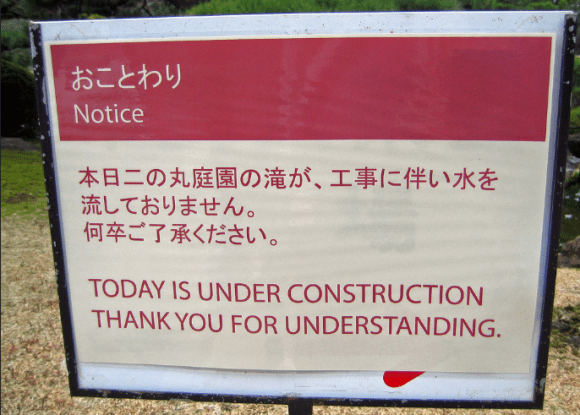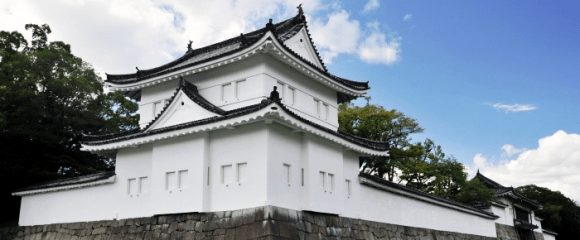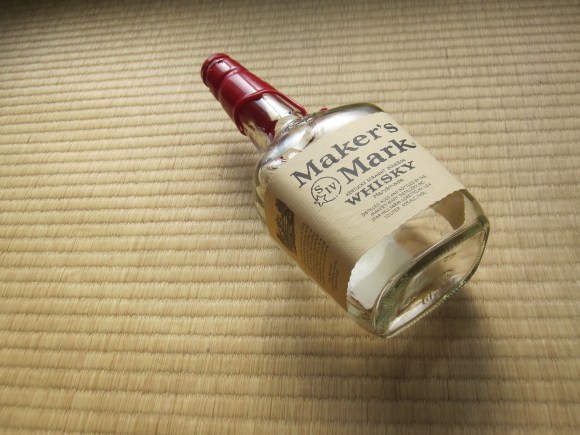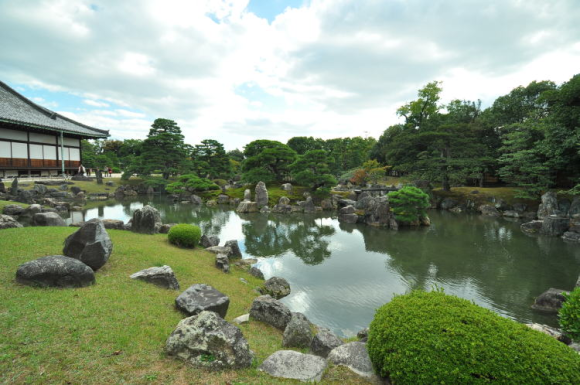
Over the years, Japan has earned a reputation for its awkward command of English, with results ranging from the perplexing to downright hilarious. The country’s translation screw-ups are so common that they’ve even earned their own collective name, “Engrish.”
But for all the sites that poke fun at Engrish, it’s almost impossible to find one that talks about why it happens. So today we’re offering a bit of explanation along with the laughs, as we look at a sign in Japan that informs English-reading passersby that “Today is under construction.”
The photo of the sign has actually been floating around online for some time now, but it’s recently caught the attention of Japanese Internet users who are linguistically savvy enough to appreciate the humor. The snapshot was originally taken by a foreign visitor to Kyoto’s Nijo Castle, one of the most popular tourist destinations in a city packed with sightseeing wonders.
As one of the few castles built in a rare period of peace during Japan’s feudal era, Nijo Castle is surrounded by extensive gardens, and in one you’ll find a waterfall.
The castle receives thousands of visitors every year, and rather than deny travelers a chance to see the historic site by regularly shutting it down, maintenance and gardening often take place even as guests mill about. So when workmen had to temporarily stop the garden waterfall, they put up a sign, the Japanese on which means:
“Please understand that, due to maintenance, the waterfall in the outer garden is not flowing today.”
For the sake of international travelers, there was also an English explanation. It was kind of the castle’s curators to consider those who don’t speak Japanese, but sadly the English translation didn’t come out quite right.
So how exactly did things end up like this? Well, most sightseeing spots in Japan don’t keep an in-house translator on the payroll, and if you’ve ever read an English tourism pamphlet that sounded natural, it was probably the work of a contracted freelance translator.
While translation isn’t on the same lucrative level as fields such as finance, law, and medicine, trying to find a qualified translator willing to accept an offer for a one-sentence project is pretty hard to do. So in the case of these super-short translations, they’re usually done by whichever Japanese staff member has the best command of English and also has time to spare, which in routinely overworked, understandably sleepy Japan really cuts down the candidate pool.
Okay, so we see how the translation probably got passed off to someone who was less than an ideal match for the job, but how did it get so off course? The person who decided on “Today is under construction” has got to be a real moron, right?
▼ “Tanaka, get over here! I’ve got a job for you.”
Not really. For example, imagine if I asked you to translate the sentence, “Due to maintenance, the waterfall in the outer garden is not flowing today” into a foreign language that’s not really your forte. Being eloquent becomes a secondary goal, and the main purpose is just to get the point across. So maybe you cut “Due to maintenance, the waterfall in the outer garden is not flowing today” down to “Today, the waterfall is under maintenance.”
That’s probably what whomever wrote the sign’s English version was going for. The problem is, Japanese and English grammar sometimes work very differently from one another. In Japanese, you can often cut the subject out of a sentence completely and it still makes perfect sense. For example, when my wife comes home tonight and I tell her, “I’ve been drinking bourbon since noon,” I can omit ore/I from the sentence, and just tell her “Hiru kara baabon wo nondeiru.” As long as I haven’t mentioned anyone else who I could possibly be talking about in the conversation, the “I” is implied by context.
▼ Plus the smell of hard liquor on my breath
Knowing that, it’s not too difficult to see how “Today, the waterfall is under maintenance” got chopped down once again (losing its comma in the process) and became “Today is under maintenance.”
But it’s not just grammar where English and Japanese are different, but sometimes in how vocabulary works, too.
In English, we usually use “maintenance” for fixing something that already exists, and “construction” for building something new. Sometimes in Japanese, though, the word kouji, which is used on the top half of the sign from Nijo Castle, can mean either “construction” or “maintenance,” particularly if you’re talking about something like a building or its fixtures, for which a manmade garden waterfall applies.
▼ A garden with this much rockwork requires a lot of kouji.
Again, bearing in mind that the intended message of the sign’s English version has been simplified from the Japanese original, we’re not dealing with someone who’s truly bilingual here. Crack open a Japanese-to-English dictionary, and 99 times out of 100 the first definition for kouji that jumps out is going to be “construction.”
So if we track the translation process from start to finish, it ends up like this:
Due to maintenance, the waterfall in the outer garden is not flowing today
↓
Today, the waterfall is under maintenance.
↓
Today is under maintenance.
↓
Today is under construction.
And hey, let’s not overlook that whoever wrote the English version knew that the literal translation of the Japanese phrase Douzo go-ryoushou kudasai, “Please consent,” sounded too heavy-handed in English and instead rendered it as the much more hospitable “Thank you for understanding.”
So the next time you come across some Engrish, go ahead and chuckle, because a lot of it is legitimately funny. But at the same time, take a second to remember that the cause might be someone pulling double duty outside their comfort zone.
In any case, if you need to read the translation in the first place, this…
…is probably still a lot more intelligible to you than this…
…so you may as well be happy for what you’ve got.
Photo source: J Town Net, Flickr
Top image: Flickr
Insert images: Nijo Castle, Blogspot, RocketNews24, Zaq







 Why Does Engrish Happen in Japan? Moon ultra parking edition
Why Does Engrish Happen in Japan? Moon ultra parking edition Why Does Engrish Happen in Japan? – Breakfast buffet edition
Why Does Engrish Happen in Japan? – Breakfast buffet edition Hello Kitty Choco Egg figures are an adorable trip through three periods of Japanese pop culture【Pics】
Hello Kitty Choco Egg figures are an adorable trip through three periods of Japanese pop culture【Pics】 Hayao Miyazaki says Happy New Year to Studio Ghibli fans with new art for Year of the Horse
Hayao Miyazaki says Happy New Year to Studio Ghibli fans with new art for Year of the Horse Starbucks Japan ready to get Year of the Horse started with adorable drinkware and plushies【Pics】
Starbucks Japan ready to get Year of the Horse started with adorable drinkware and plushies【Pics】 Attack on Titan x Uniqlo pairing unleashes a colossal collaboration on the world
Attack on Titan x Uniqlo pairing unleashes a colossal collaboration on the world Man Frames Octopus for Murder or Vice-Versa, Trial Ongoing in South Korea
Man Frames Octopus for Murder or Vice-Versa, Trial Ongoing in South Korea Japanese thug wear from Birth Japan perfect for those breaking bad next year
Japanese thug wear from Birth Japan perfect for those breaking bad next year Pizza Hut Japan’s hot lucky bags are perfect for a New Year’s pizza party
Pizza Hut Japan’s hot lucky bags are perfect for a New Year’s pizza party Japan has a special foil for roasting sweet potatoes at home, and it’s like having a time machine
Japan has a special foil for roasting sweet potatoes at home, and it’s like having a time machine Alcohol Made with Fermented Wasps Gives New Meaning to the Phrase “Get Your Buzz On”
Alcohol Made with Fermented Wasps Gives New Meaning to the Phrase “Get Your Buzz On” Starbucks Japan unveils new Sakura Frappuccino for cherry blossom season 2025
Starbucks Japan unveils new Sakura Frappuccino for cherry blossom season 2025 7-Eleven Japan’s ramen-cooking robot whipped us up a bowl of noodles【Taste test】
7-Eleven Japan’s ramen-cooking robot whipped us up a bowl of noodles【Taste test】 Cyberpunk anime meets traditional culture in Ghost in the Shell gold leaf Japanese changing screens
Cyberpunk anime meets traditional culture in Ghost in the Shell gold leaf Japanese changing screens 7 great places to see Mt. Fuji from without having to climb it
7 great places to see Mt. Fuji from without having to climb it Japan’s otoshidama tradition of giving kids money at New Year’s gets a social welfare upgrade
Japan’s otoshidama tradition of giving kids money at New Year’s gets a social welfare upgrade We found possibly the quietest Japanese-style hotel in Tokyo’s bustling Shinjuku district
We found possibly the quietest Japanese-style hotel in Tokyo’s bustling Shinjuku district Lacquerware supplier to emperor of Japan and Pokémon team up for new tableware
Lacquerware supplier to emperor of Japan and Pokémon team up for new tableware Sumo Sanrio! Hello Kitty and pals team up with Japan Sumo Association for new merch【Pics】
Sumo Sanrio! Hello Kitty and pals team up with Japan Sumo Association for new merch【Pics】 Can a dirty butthole make you filthy rich in Japan? We’re starting a New Year’s lottery experiment
Can a dirty butthole make you filthy rich in Japan? We’re starting a New Year’s lottery experiment 7-Eleven Japan starts new temporary luggage storage service in over 300 branches
7-Eleven Japan starts new temporary luggage storage service in over 300 branches Disillusionment at Tsukiji’s tourist-target prices led us to a great ramen restaurant in Tokyo
Disillusionment at Tsukiji’s tourist-target prices led us to a great ramen restaurant in Tokyo Starbucks teams up with 166-year-old Kyoto doll maker for Year of the Horse decorations【Photos】
Starbucks teams up with 166-year-old Kyoto doll maker for Year of the Horse decorations【Photos】 Tokyo considering law requiring more trash cans following litter increase in heavily touristed area
Tokyo considering law requiring more trash cans following litter increase in heavily touristed area Tokyo’s Tsukiji sushi neighborhood asks tour groups to stay away for the rest of the month
Tokyo’s Tsukiji sushi neighborhood asks tour groups to stay away for the rest of the month Nintendo’s Kirby now delivering orders at Kura Sushi restaurants, but not in Japan
Nintendo’s Kirby now delivering orders at Kura Sushi restaurants, but not in Japan Tokyo event lets you travel back in time, for free, to celebrate 100 years since Showa era start
Tokyo event lets you travel back in time, for free, to celebrate 100 years since Showa era start Sanrio theme park in Japan announces plans to expand into a Sanrio resort
Sanrio theme park in Japan announces plans to expand into a Sanrio resort Japan may add Japanese language proficiency, lifestyle classes to permanent foreign resident requirements
Japan may add Japanese language proficiency, lifestyle classes to permanent foreign resident requirements Survey asks foreign tourists what bothered them in Japan, more than half gave same answer
Survey asks foreign tourists what bothered them in Japan, more than half gave same answer Japan’s human washing machines will go on sale to general public, demos to be held in Tokyo
Japan’s human washing machines will go on sale to general public, demos to be held in Tokyo Japan’s deadliest food claims more victims, but why do people keep eating it for New Year’s?
Japan’s deadliest food claims more victims, but why do people keep eating it for New Year’s? We deeply regret going into this tunnel on our walk in the mountains of Japan
We deeply regret going into this tunnel on our walk in the mountains of Japan Studio Ghibli releases Kodama forest spirits from Princess Mononoke to light up your home
Studio Ghibli releases Kodama forest spirits from Princess Mononoke to light up your home Major Japanese hotel chain says reservations via overseas booking sites may not be valid
Major Japanese hotel chain says reservations via overseas booking sites may not be valid Put sesame oil in your coffee? Japanese maker says it’s the best way to start your day【Taste test】
Put sesame oil in your coffee? Japanese maker says it’s the best way to start your day【Taste test】 No more using real katana for tourism activities, Japan’s National Police Agency says
No more using real katana for tourism activities, Japan’s National Police Agency says Starbucks Japan reveals new sakura drinkware collection, inspired by evening cherry blossoms
Starbucks Japan reveals new sakura drinkware collection, inspired by evening cherry blossoms Updated cherry blossom forecast shows extra-long sakura season for Japan this year
Updated cherry blossom forecast shows extra-long sakura season for Japan this year Kyoto accidentally calls all old people “terrible drivers”【Why Does Engrish Happen in Japan?】
Kyoto accidentally calls all old people “terrible drivers”【Why Does Engrish Happen in Japan?】 Why Does Engrish Happen in Japan? 30-year-old fart-related signage mistake edition
Why Does Engrish Happen in Japan? 30-year-old fart-related signage mistake edition Tokyo hotel asks guests to take their used toilet paper with them【Why Does Engrish Happen?】
Tokyo hotel asks guests to take their used toilet paper with them【Why Does Engrish Happen?】 Japanese park’s English dog turd warning minces no words【Why does Engrish happen?】
Japanese park’s English dog turd warning minces no words【Why does Engrish happen?】 Japanese tourist center asks small-penised travelers to not make a mess in the bathroom
Japanese tourist center asks small-penised travelers to not make a mess in the bathroom Official Tokyo Marathon T-shirts get recalled for English spelling mistake
Official Tokyo Marathon T-shirts get recalled for English spelling mistake Engrish sign at the Tokyo Olympics turns out to be hilariously accurate
Engrish sign at the Tokyo Olympics turns out to be hilariously accurate Top 20 castles to visit in Japan in 2017
Top 20 castles to visit in Japan in 2017 The top 10 Castles in Japan to visit in 2019, as ranked by TripAdvisor users
The top 10 Castles in Japan to visit in 2019, as ranked by TripAdvisor users Sakura in Japan 2019: The best spots for hanami cherry blossom viewing
Sakura in Japan 2019: The best spots for hanami cherry blossom viewing Japan travel bucket list: top places to visit in each prefecture before you die【Part II】
Japan travel bucket list: top places to visit in each prefecture before you die【Part II】 Ghibli Park: Opening date, first photos, and a new promo video produced by Studio Ghibli!
Ghibli Park: Opening date, first photos, and a new promo video produced by Studio Ghibli! Japan travel on a budget: Top 20 free attractions around the country, compiled by TripAdvisor
Japan travel on a budget: Top 20 free attractions around the country, compiled by TripAdvisor How many have you seen? 18 must-visit sites in Japan 【World Heritage】
How many have you seen? 18 must-visit sites in Japan 【World Heritage】 Japan Travel: 17 Things to do in Oita, Japan’s onsen prefecture
Japan Travel: 17 Things to do in Oita, Japan’s onsen prefecture
Leave a Reply